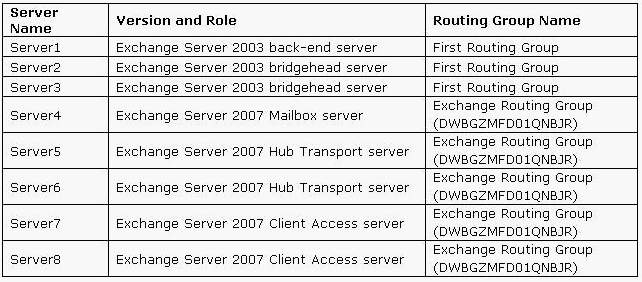You are the messaging engineer for your company.
The Microsoft Exchange servers in your organization are configured as shown in the following table:
You need to ensure that message routing is redundant between the Exchange Server 2007 and the Exchange Server 2003.
Which two configurations should you recommend? (Each correct answer presents part of the solution.
Choose two.)

A.
Configure network load balancing between Server2 and Server3.
B.
Configure network load balancing between Server7 and Server8.
C.
Create a Send connector that uses Server5 and Server6 as source transport servers. Specify the organizations SMTP domain name as the address space. Use Server2 and Server3 as smart hosts.
D.
Configure the routing group connector that connects the First Routing Group to Exchange Routing Group (DWBGZMFD01QNBJR) to use Server2 and Server3 as source transport servers and to use Server5 and Server6 as target transport servers.
E.
Configure the routing group connector that connects the Exchange Routing Group
(DWBGZMFD01QNBJR) to the First Routing Group to use Server5 and Server6 as source transport servers and to use Server2 and Server3 as target transport servers.
Explanation:
Exchange 2003 uses the routing group concept to define a set of servers joined in a high speed network link, and routing group connectors to forward messages between such routing groups. Mail servers located in the same group communicate directly with each other without requiring any connectors. Exchange 2007, on the other hand, uses the existing AD site map to define its routing topology and the Hub role to transfer mail between these sites.Combining Exchange 2007 and 2003 machines in the same Routing Group isnt supported. Instead, when the first Hub server is installed in an existing 2003 organization, all Exchange 2007 computers hosted there are automatically incorporated in a single, global 2007 group. This is recognized by 2003 ESM as Exchange Routing Group (DWBGZMFD01QNBJR).
This default Routing Group or any Routing Group Connectors which include a 2007 Hub server, as either source or target, cant be managed by either 2003 ESM or 2007 EMC. Instead, you must use the EM Shell. When an organization is running in a mixed environment, a Routing Group Connector is used to transmit messages between 2007 Hub and 2003 Bridgehead servers. If you disable referrals on this connector, users with 2003 mailboxes wont be able to view any public folders hosted on the 2007 Mailbox servers.
http://technet.microsoft.com/en-us/library/bb125223.aspx
Use New-RoutingGroupConnector to establish a connection between the 2007 routing group and any 2003 routing group when the organization is running more than one version of Exchange.
http://technet.microsoft.com/en-us/library/aa998574(EXCHG.80).aspx
Use Set-RoutingGroupConnector to modify properties of an existing connector. Also to set the maximum message size that can pass across a connector. Use SourceTransportServers to specify servers used to send messages to the target servers. Use TargettransportServers for servers that will receive messages from the source servers. Separate multiple entries by a comma. Source and target machines must be 2007 Hub or 2003 Bridgehead servers. Values overwrite existing entries.
Legacy servers are automatically added to the ExchangeLegacyInterop USG. By default, Exchange 2007 grants group members Send to and Receive from permissions on Hub servers. Use PublicFolderReferralsEnabled to determine if users can use this connector to access a PF replica in the routing group of the target servers when a PF instance isnt available in the local group (Default, $true).
http://technet.microsoft.com/en-us/library/bb232193.aspx
http://www.msexchange.org/tutorials/Implementing-Exchange-Server-2007-coexistence-Exchange-Server-2003.html
http://technet.microsoft.com/en-us/library/bb232209.aspx


